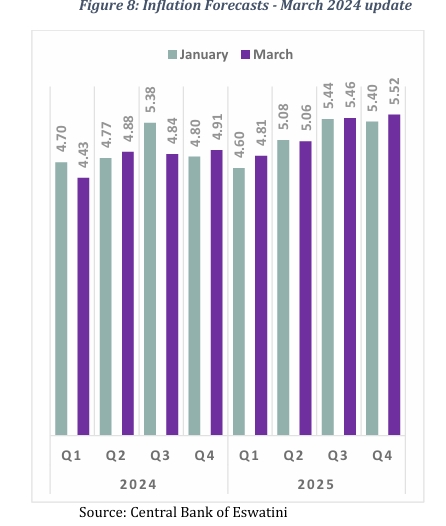By Bahle Gama

Inflation in 2025 is forecasted to rise in line with the anticipated higher food prices as well as the expected higher oil price pressures in the medium term.
The Eswatini Quarterly Economic Bulletin published by the Ministry of Economic Planning and Development, Macroeconomic Analysis and Research Unit states that the expected slight depreciation in the Rand is also expected to increase inflation in 2025.
However, in 2026, inflation has been revised upwards to 5.37 per cent.
According to the bulletin, the 2024 forecast for domestic headline inflation remained unchanged at 4.91 per cent in the quarter under review.
ALSO READ: High inflation means children go…
Global oil prices are still expected to remain elevated mainly due to the prolonged crude oil production cuts coupled with pressure emanating from imported inflation from the SA economy mainly for finished goods and services.
On the domestic front, the recent increasing adjustment in fuel prices and expected utility tariff hikes are expected to apply upward pressure on inflation.
The inflation forecast for the first quarter of 2024 is slightly reviewed down to 4.43 per cent from the previously forecasted 4.70 per cent.

The country’s headline inflation averaged 4.3 per cent in the first quarter of 2024, which was a 0.4 percentage point decrease from the 4.7 per cent recorded in the previous quarter.
The decline in headline inflation was mainly on account of a fall in the prices of ‘food and non-alcoholic beverages’ decelerating by 3.8 percentage points, and ‘housing & utilities’ falling by 0.1 percentage points. In contrast, ‘transport’ prices surged by 1.3 percentage points to an average of 1.2 per cent in the quarter under review.
Eswatini’s core inflation, increased by 0.6 percentage points relative to the previous quarter and averaged 3.7 per cent in the period. On the other hand, administered prices, increased by 1.1 percentage points relative to the previous quarter.
ALSO READ: South Africa’s path to inflation…
On a quarter-to-quarter comparison, the fall in the prices of ‘food and non-alcoholic beverages’ was owing to developments in bread and cereals which decelerated by 4.9 percentage points.
Notably, within this category, prices for other cereals, flour, and other products moderated significantly to average -3.0 per cent relatively 10.8 per cent in the previous quarter.
Similarly, meat prices also reflected a deceleration of 3.9 percentage points to an average of 2.7 per cent. Moreover, poultry prices fell by 5.4 percentage points to an average of 1.8 per cent in the period. In the same vein, the prices of ‘housing and utilities’ slightly declined by 0.1 percentage point to average 7.9 per cent driven by the prices of gas and liquid fuels.
On the contrary, there was a notable increase in the ‘transport’ category by 1.3 percentage points, owing to the acceleration in the prices of ‘purchase of vehicles’ and ‘fuels, lubricants for personal transport equipment’ in the first quarter of 2024.
Notably, the growth in ‘transport’ prices reflected the cumulative E1.10 change in the petrol and diesel pump prices in the quarter.






